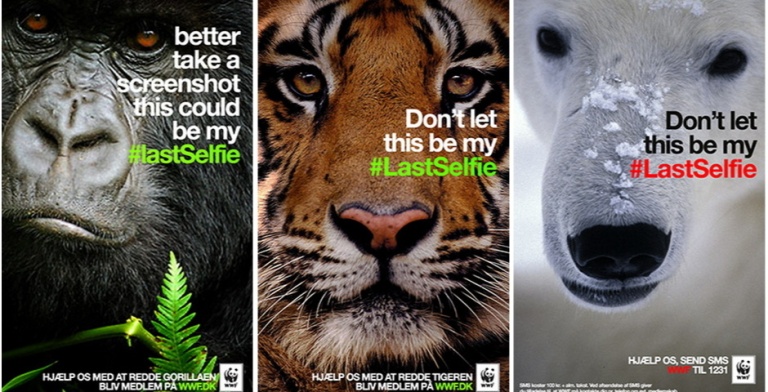How can a wildlife conservation organization communicate the urgency and importance of continuous efforts toward the preservation of endangered species?
Um… Snapchat. Duh.
The World Wildlife Fund exists as the world’s leading conservation organization, functioning in 100 countries and boasting five million members globally, 1.2 of which reside in the United States. This intelligent team knew that in order to reach new audiences, they had to get innovative. What they came up with was the brilliant “#LastSelfie” campaign, which featured endangered animals in a somewhat selfie-like pose with the caption “Don’t let this be my #LastSelfie.”

WWF took to image messaging application Snapchat to raise awareness among millennials and to increase donations to the fund. Snapchat is commonly used by young adults to send photos and videos (mostly selfies) to their friends to update them on their daily activities. Snapchat was an excellent choice for this campaign for numerous reasons. First of all, Snapchat allows users to communicate with each other by sending pictures that can only be viewed for a sender-determined number of seconds. This provided the opportunity for a perfect metaphor: just as the photos are disappearing as quickly as they are viewed, so is much of the world’s endangered wildlife.
The second, and primary, reason why Snapchat was an effective platform choice is because of who uses it. WWF chose to target a millennial audience with the #LastSelfie campaign in hopes of bringing awareness to the demographic and consequently increasing fund donations. Therefore, the organization needed to pinpoint where in the social sphere millennials are extremely active. WWF hit the nail on the head: 71% of Snapchat users are age 25 and under.
As far as donations go, the campaign managed to increase donations for the entire month in only a matter of days. This was, in part, due to effective audience targeting. Millennials are typically environmentally and socially conscious, and 61% of millennials say they are worried about the state of the world and feel personally responsible to make a difference. These attitudes made millennials a perfect target to increase WWF donations.
Another part of the successful increase of donations involved the ideal selection of a message that would appeal the most effectively to the target audience. The selfie can only be described as a global phenomenon that has become insanely integrated into today’s culture ever since the dawn of the front-facing camera. In fact, people born after the year 1980 are expected to take 25,000 selfies in their lifetime, and over one million selfies are taken every single day. Selfies are kind of a big deal.
Which makes the selfie the perfect medium to connect with millennials on a personal level and inspire them to become invested in a cause. WWF spoke in the language of the millennials and sent out Snapchats of endangered animals’ seemingly “last selfies.”
This campaign perfectly identified its target audience and chose impeccable messaging to spread awareness and get the audience to act in the organization’s interest, which is why it was recognized at the 2015 Webby Awards. Let this be a lesson to us all that we must go wherever our audience is, for that is the only way to succeed.
Cheers.
